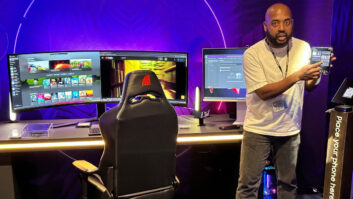Since walking into his new post as president of Philips Consumer Electronics North America nine months ago, Larry Blanford has seen his share of challenges while trying to make the company a digital leader.
Aside from a stifling economy and the market aftershock of the Sept. 11th atrocity that has hampered all businesses, Blanford has the mission of returning Philips to first or second market-share positions in all of the categories in which it competes.
This, he said, is no small task, given that prior managers had spent hundreds of millions on advertising and merchandising programs but achieved only partial success. The effort was helping the company replace the stodgy Magnavox image in consumers’ minds with that of Philips as a new digital innovator. But the company was still finding it hard to get into the “upmarket” retailers that are necessary to sell its leading edge products.
Today, Blanford assures, Philips is on the road to realizing its goals.
“When I walked in, there were some disconnects between our aspirations for the company in North America and the reality of the situation,” Blanford observed.
“We are now very clear about who our target customers are, what our product road maps needs to be, what our brand positioning is, what channels we need to serve (both for the Philips brand and secondarily for the Magnavox brand), and what our strategy will be going forward.”
The company is also taking this message to retailers in an attempt to repair some lapsed relationships.
“Philips had not been consistent in its approach over the past seven years, and as a result, the trade really didn’t know what the brand stood for any longer,” he said.
As a result, Philips dumped its short-lived Philips Magnavox tandem trademark, which Blanford called “confusing,” opting instead to use Philips for digital products and Magnavox for analog and more commodity oriented goods.
Additionally, the company began a “door-to-door” campaign to get more “upmarket” retailers back on board.
“In discussions with senior retail leaders in North America, I’ve found there is at one level a very high regard for Philips,” he said. “They’ve seen the strength of Philips in other markets of the world, and they’ve seen Philips as a giant that hasn’t quite gotten its act together in North America. They’ve been waiting to see Philips come forward in a focused way.”
Philips has started to revamp its national advertising to feature products that are availabe in stores, and not just impressive technology statements from Europe.
“In past campaigns, the consumers’ experience of what they saw in retail stores was quite different from what was coming through in the advertising,” he stated.
Blanford said Philips views North America as a primary market and is now coordinating the simultaneous release of its hottest technologies both here and abroad.
At the same time, Philips will continue to spend heavily on consumer advertising (almost $250 million has been spent in the last three years). This year’s ads will highlight widescreen televisions and DVD+RW video recorders.
The new messages in the campaign will focus on “the global essence of the Philips brand” with more “local expression.” In some cases, this will mean dealer tie-ins in for local print spots.
Philips has also developed a “calendar program with key events that leverage relationships we are building with other great brands. We also intend to continue leveraging content from a number of studios going forward,” he said.
Another fix has been to step up market testing of both products and commercials.
“One of the weaknesses of the business in the past has been a bit of hip shooting without a solid understanding of the consumer,” he said.
In addition to DVD+RW format video recorders, digital widescreen television will be a signature statement from Philips this year.
Due in part to in adequate supply, Blanford acknowledged that Philips digital TV market share is well below the No. 1 or 2 positions it must achieve.
To correct that, Philips is increasing production, expanding it DTV rear projection line and enhancing digital direct-view televisions with an upmarket MatchLine series carrying Philips’ exclusive Pixel Plus technology. The video processing technology, which Philips will demonstrate at the show, increases both the horizontal and vertical resolution of standard definition signals to create near HDTV-quality pictures.
With time, Blanford said he believes Philips will be able to achieve a market leading position in DTV without resorting to the price slashing practices that had market the Magnavox of old.
“Where we have demonstrable performance advantages, which we generally do in upmarket television, we will fight hard to maintain a premium over a number of competing brands,” he said. “As that whole set of brands moves in pricing, we move up and down with them. But where we have advantages, we will maintain that premium and work harder to communicate the benefits to the consumer.”













